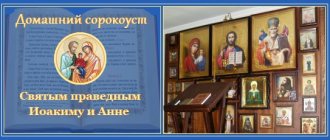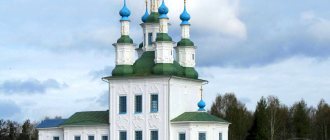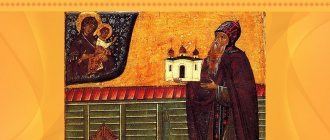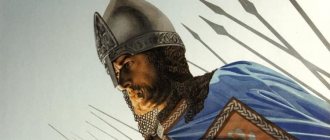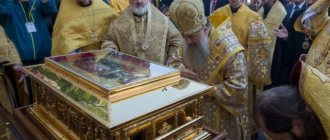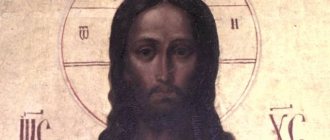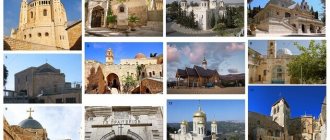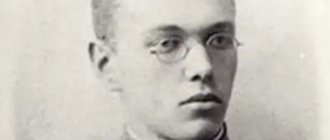Troparion, voice 4*
Your fasting and equal angelic life, / the reverend fathers Zosima and Savvatie, / made you known by the universe; / you enlighten with various miracles, God-bearing ones // by faith you call and honor the honest your memory.
Translation: By your fasting and similar angelic life, Reverend Fathers Zosima and Savvaty, you became known throughout the entire earth; With various miracles, O God-bearing Ones, you enlighten with faith those who call upon you and honor your sacred memory.
The meaning of the akathist to Zosima, Savvaty and Herman Solovetsky in Orthodoxy
The role of the Solovetsky holy fathers in the development and formation of the Orthodox faith is great and undeniable. The text of the akathist tells about their physical and spiritual exploits, about their mission, a mentoring example of true obedience for the brethren. The life of the elders, their zeal in comprehending the true faith, and good deeds became the embodiment of a godly existence, which became a model for many servants of the Lord.
With their steadfastness of body, spiritual purity, and tireless prayer, the venerable elders Zosima, Savvaty and German earned the favor of the Lord God, who endowed the elders with the gift of clairvoyance and miracle-working. By strengthening their own faith, they converted others to faith and became examples of obedience. The Akathist glorifies the godly life of the holy fathers, tells about their deeds and humble greatness.
Kontakion, voice 2*
By the love of Christ, the reverends, wounded, / and naturally carried His cross on a frame, / divinely armed against invisible enemies, / and unceasing prayers, like a copy in the hands, and more powerfully,/ we have firmly defeated the natural hosts of demons;/ the grace of the Lord is accepted to heal the ailments of souls and the bodies/ of your venerable relics flowing to the crayfish,/ emitting rays of miracles everywhere./ Thus we call to you:/ Rejoice, reverend Fathers Zosimo and Savvatie, // fertilizer for the monks.
Translation: Inflamed with the love of Christ, reverends, and taking His Cross on your shoulders, you carried it, divinely armed against invisible enemies and holding incessant prayers like a spear in your hands, you courageously defeated the demonic armies, having received grace from the Lord to heal the diseases of the souls and bodies of those who come to crayfish with your revered relics, everywhere you emit rays of miracles. Therefore we appeal to you: “Rejoice, venerable fathers Zosima and Savvaty, adornment of the monks.”
Herman Solovetsky
Brief life of St. Herman of Solovetsky
The Monk Herman Solovetsky was from the city of Totma, Perm diocese. Before other monks, he visited Solovki. Perhaps he visited the Solovetsky Islands in 1428 with the Pomors, but did not dare to live there alone. He returned to the Pomeranian coast and stayed at the chapel in the village of Soroka on the Vyg River, where he met the Monk Savvaty.
In 1429, the ascetics moved to the deserted Solovetsky Island and spent about six years in labor, fasting and prayer. Daily work constituted the main feat of the Monk Herman. In 1435, when the Monk Savvaty died, the monk Herman briefly returned to the mainland and met the hermit Zosima. In 1436 they reached the Big Solovetsky Island and soon founded a cenobitic monastery.
The ascetic Herman worked for more than 40 years at the monastery under Abbot Zosima. Without abandoning the feat of prayer, he made sea crossings, overcame the natural hardships of the northern region in everyday labors, and together with the brethren erected churches. Elder Herman's oral narratives about the Solovetsky ascetics Savvatiya and Zosima, recorded at his request, were later used in the compilation of their lives.
In 1479, the Monk Herman, fulfilling the instructions of Abbot Arseny, the successor of the Monk Zosima, went to Novgorod. Illness prevented him from returning to the islands. At the monastery of St. Anthony the Roman, the ascetic took communion of the Holy Mysteries of Christ and peacefully surrendered his soul to God. The Solovetsky monks were unable to take his body to the monastery due to muddy roads and buried him in the village of Khovronyina on the banks of the Svir River.
Five years later, under Abbot Isaiah, the brethren transferred the holy relics of St. Herman to the Solovetsky monastery and placed them next to the relics of St. Savvaty. Later, a chapel was erected over the burial place of St. Herman, and in 1860 a stone church was built, consecrated in his honor.
Since 1692, with the blessing of Patriarch Joachim, church veneration of the Monk Herman was established.
Nowadays the holy relics of the founders of the monastery, Saints Zosima, Savvaty and Herman, the Solovetsky Wonderworkers, rest in the Church of the Annunciation of the Blessed Virgin Mary.
Prayer 1*
Oh, our reverend and God-bearing fathers Zosimo and Savvatie, earthly angels and heavenly people, close friends of Christ and saints of God, your abodes are glory and adornment, all Northern countries, especially our entire Orthodox Fatherland, an insurmountable wall and a great intercession! Behold, we, unworthy and many sinners, with reverent love for the relics of your honorable relics, fall, with a contrite and humble spirit we diligently implore you: pray unceasingly to the Blessed Master and Lord for our Jesus Christ, for there is great boldness in those who have it, so that His all-effective grace may not depart from us , the protection and intercession of the Most Holy Lady of our Mother of God may abide in this place and may the true zealots of the angelic life never fail in this holy monastery, where you, God-bearing fathers and bosses, immeasurable labors and forgiveness, tearful and all-night vigils, unceasing prayers and make the beginning of monastic life with prayer. To her, saintly saints, most favorable prayers to God, with your warm prayers to Him, protect and save us and your holy village from coward, flood, fire and sword, invasion of foreigners and deadly ulcers, from enmity and all kinds of disorder, from all misfortune and sorrow and from all evil, may the Most Holy Name of the Lord and God be reverently glorified in this place in peace and silence, and those who wait for Him may find eternal salvation. O blessedness, our fathers Zosimo and Savvatie! Hear us, sinners, in your holy monastery and under the roof of your protection, those who live unworthily, and through your powerful petitions to God, ask our souls for the remission of sins, life - correction and perception of eternal blessings in the Heavenly Kingdom; To all believers, who in every place and in every need call on you for help and intercession, and who flow into your abode with reverent love, do not cease to pour out all grace and mercy, preserving them from all opposing forces, from all adversity and from all evil circumstances and giving them everything they need for mental and physical benefit. Most of all, pray to the Most Merciful God, that He may establish and strengthen His holy Church and all our Orthodox Fatherland in peace and silence, in love and unanimity, in orthodoxy and piety, and preserve This is forever and ever. Amen.
Savvaty Solovetsky
Brief life of St. Savvaty of Solovetsky
The Monk Savvaty was a monk of the Kirillo-Belozersky Monastery. Humility, meek love for the brethren and strict life earned him respect not only from the monks, but also from the laity. Weighed down by such attention, the Monk Savvaty went to Valaam, then, having learned about the deserted islands that were two days' sail from the shore of the White Sea, he sailed there with the Monk Herman. The ascetics settled near Sekirnaya Mountain on Solovetsky Island, where they erected a cross and set up a cell. The ascetics lived together for six years. On September 27, 1435, the Monk Savvaty passed away into eternity.
Complete life of St. Savvaty of Solovetsky
The Monk Savvaty of Solovetsky came to the Kirillo-Beloezersky Monastery in 1396, where he took monastic vows. There he labored for a long time, unquestioningly fulfilling all obediences. Humility, meek love for the brethren and strict life distinguished the Monk Savvaty among other ascetics. Soon he began to be burdened by the attention and respect of the brethren and the laymen who came and, having learned that there was a rocky island of Valaam on Lake Ladoga, he decided to move there. Grieving heavily, the brethren of the Kirillo-Beloezersk monastery said goodbye to the holy elder. On Valaam, worldly fame also began to bother the humble old man. Meanwhile, the monk learned that in the north there was an uninhabited Solovetsky Island; he began to ask the abbot for his blessing to settle there in solitude. However, the abbot and the brethren did not want to part with the holy elder. At the direction of God, the Monk Savvatiy left the Valaam monastery at night and headed to the shores of the White Sea. When he learned from the locals that the island was two days' sail away, that there were many lakes on it and that no one lived on the island, he became even more eager to settle there. Surprised residents asked the gray-haired ascetic how he would live there and what to eat. “I have such a Lord,” answered the monk, “who gives strength to fresh youth to decrepitude, and feeds the hungry to their full.”
For some time the Monk Savvaty remained in the chapel, which stood near the mouth of the Vyga River, in the town of Soroki. There he met with the Monk Herman, who labored as a hermit, and together they decided to move to the island. On a fragile boat, having prayed to God, the elders set off across the harsh sea and three days later reached Solovetsky Island. The ascetics settled near Sekirnaya Mountain, where they erected a cross and set up a cell. In the harsh conditions of the North, the elders labored for several years and with their exploits they sanctified the deserted island. And here, at times, the enemy of humanity, the devil, tempted the holy elders. A certain fisherman and his wife, driven by a feeling of envy, once arrived on the island and settled not far from the ascetics. But the Lord did not allow the laity to establish themselves next to the elders. Two young men with bright faces appeared to the fisherman’s wife and flogged her with rods. The fisherman got scared, quickly packed his things and hurried to return to his previous place of residence. Once, when the Monk Herman went to the Onega River for his cell needs, the Monk Savvaty, left alone, felt the approach of death and turned to God with a prayer that He would grant him communion of the Holy Mysteries. In two days the monk sailed to the mainland and ten miles from the Vyga River he met Abbot Nathanael, who was going to a distant village to give communion to a sick peasant. Hegumen Nathanael was delighted to meet the monk, fulfilled his wish and listened to the story of his exploits on the island. Having said goodbye, they agreed to meet in a temple on the Vyge River.
Arriving at the temple, the holy elder prayerfully thanked God for Communion; he shut himself up in a cell located near the temple and began to prepare for his departure to the eternal villages. At that time, the Novgorod merchant John landed on the shore and, having bowed to the holy icons in the temple, came to the holy elder. Having received blessing and instruction, he offered the monk part of his wealth and was saddened when he heard the refusal. Wanting to console the merchant, the Monk Savvaty invited him to stay until the morning and promised prosperity on his further journey. But John was in a hurry to sail. Suddenly an earthquake began and a storm arose at sea. Frightened, the merchant remained, and in the morning, entering the cell for a blessing, he saw that the elder had already passed away. Together with the approaching abbot Nathanael, they buried the Monk Savvaty in the chapel and compiled a description of his life. This happened on September 27, 1435. After 30 years, the holy relics of the Monk Savvaty were transferred by the Monk Zosima († 1478; commemorated on April 17) and the brethren to Solovetsky Island and placed in the Transfiguration Church. In 1566, the relics of Saints Savvaty and Zosima were transferred to the church named in their honor (joint memory on August 8).
See also: “ The Life of our Venerable Father Savvaty of Solovetsky, the Wonderworker” as presented by St. Demetrius of Rostov.
Biography of Saints Zosima, Savvaty and Herman of Solovetsky
Reverends Savvaty and Herman sailed to the uninhabited Solovetsky Islands in 1429. Having lived in solitude for six years, the Monk Herman returned to the coast to replenish his daily supplies, and the Monk Savvaty continued his feat alone.
Anticipating his approaching death, the Monk Savvaty sailed from the island to the coast in search of a priest. There, near the Vyg River, in an area called Soroka, he met Abbot Nathanael, who was walking around this region. Having confessed and received the Holy Mysteries of Christ, the Monk Savvaty peacefully departed to the Lord on September 27, 1435. The Monk Savvaty was buried by Abbot Nathanael and the merchant John at the chapel on the Vyg River.
A year later, a native of Obonezhye, the young monk of the Paleostrovsky monastery Zosima, after meeting the monk Herman, a companion of the Monk Savvaty, went with him for a solitary residence on the Solovetsky Islands. Upon arrival, on the very first night, the Monk Zosima was awarded a prophetic vision, which inspired two monks to found the Solovetsky monastery.
After several years, the Monk Zosima, summoned by the archbishop to Novgorod, was ordained to the priesthood and awarded the elevation to the rank of hegumen. The monastery did not forget the founder of these places, St. Savvaty. On the advice of the elders of the Kirillo-Belozersky monastery to transfer the relics of the Monk Savvaty (which corresponded to the desire of the brethren of the Solovetsky monastery), the Monk Zosima transported the holy relics of the monk to the place of his last exploits. Here, behind the altar of the newly built church in honor of the Dormition of the Blessed Virgin Mary, they were laid in the ground, where they rested until 1566.
The Monk Zosima reposed before God, having reached venerable old age, on April 17, 1478. The brethren buried their abbot behind the altar of the Transfiguration Church.
A few decades later, the Church Council under Metropolitan Macarius of Moscow on February 26, 1547 determined that all-church commemoration of the Solovetsky venerable should be celebrated to each one on the day of his death: Savvaty - September 27/October 10, Zosima - April 17/30.
There is information according to which the first discovery of the relics of the reverend fathers was on September 2, 1545. This is probably due to preparations for the canonization of these ascetics at the Council of 1547.
The renowned abbot of the Solovetsky Monastery, Hieromartyr Philip (Kolychev; †1569), who became abbot in 1548, worked hard for the glory of the monastery. The holy abbot Philip discovered the miraculous image of the Mother of God Hodegetria, brought to the island by the Monk Savvatius, as well as its stone cross. These holy relics were installed at the relics of the saints: the icon - at the tomb of St. Savvatius, and the cross - in the chapel of St. Herman. The lives of the saints were also supplemented with a description of the miracles that took place at their tombs.
The celebration of the transfer of the relics of Saints Zosima and Savvaty, Solovetsky wonderworkers, took place on the third day of the Feast of the Transfiguration, after the consecration of the Transfiguration Cathedral on August 8, 1566. It was prepared and inspired by Saint Philip, the future Metropolitan of Moscow († 1569; commemorated January 9/22, July 3/16 and October 5/18). The relics of Saints Zosima and Savvaty were transferred to the chapel of the Transfiguration Cathedral, built in their honor.
The Russian people sacredly honor the memory of the Solovetsky miracle workers; they are especially revered as the patrons of beekeeping. In many places in Russia, an exhibition of bees was timed to coincide with the day of remembrance of St. Zosima “The Beekeeper” (April 17/30). On the day of remembrance of St. Savvaty (September 27/October 10), the collection of bees into the omshanik for the winter usually ends.
Prayer 2*
Oh, reverend fathers, great intercessors in sorrow and hearers of prayers, saints of God and miracle workers Zosimo and Savvatie! Don’t forget, as you promised, to visit your child. Even though you are gone from us in body, you remain with us ever in the Spirit. We pray to you, O veneration: deliver us from fire and sword, from the invasion of foreigners and civil strife, from corrupting winds, and from vain death, and from all the attacks of demons that come upon us. Hear us, sinners, and accept this prayer and our supplication, like fragrant incense, like an acceptable sacrifice, and revive our souls, evil deeds and advice and thoughts put to death, and, like a dead damsel, you have risen, like the inhealable wounds of many you have healed, from spirits deliver the unclean, those tormented by evil, and deliver us too, who are kept in the bonds of the enemy, and deliver us from the snares of the devil, bring us out of the depths of sins, and through your merciful visit and intercession from the enemy Protect us in the visible and invisible with the grace and power of the All-Holy Trinity, always, now, and forever and ever. Amen.
Reading rules
You can read the akathist to the holy elders Zosima, Savvaty and Herman of Solovetsky both within the walls of an Orthodox church and at home. In churches, clergy and parishioners read a prayer service on the dates in memory of the fathers, honoring their good mission and godly deeds, as well as at the request of believers. Many people prefer to pray at home, in solitude and at a measured pace.
For a home prayer service, it is recommended to purchase an icon depicting the holy fathers and say prayers in front of it, as well as buy church candles. The Akathist is read in a calm, peaceful atmosphere, without being distracted by pressing concerns. Traditionally, a candle or lamp is lit in front of the icon of saints. A burning flame helps you calm down and focus on prayer.
According to Orthodox principles, it is customary to pray while standing, but if a person’s physical condition does not allow this, he is allowed to sit or lie down during the prayer service. You need to read the akathist thoughtfully, slowly, pronouncing and realizing the meaning of each spoken word. You cannot be distracted, including mentally. All attention should be directed to the prayer service.
You can read the akathist to the holy fathers of Solovetsky on certain days, memorable dates and at times of turning to the righteous for help. A forty-day cycle of reading the akathist will strengthen prayer many times over. In this case, they confess in advance in church, take communion and read the akathist every day for 40 days. It is also advisable to receive the priest's blessing.
We must remember that, praying and trusting in help from above, it is necessary to live according to the Law of God, have pure thoughts and good intentions, and lead a righteous, God-pleasing lifestyle. You need to turn to the saints sincerely, with holy faith in the heavenly grace, power and wisdom of the Lord God. The requests of true believers and pious Christians will be heard in Heaven.
Prayer 3, St. Savvaty of Solovetsky**
Oh, reverend father, saint of Christ Savvatie, who loved the Lord with all his soul, and retired into this desert, and completed the course of the feat of salvation! Oh, faithful servant of the Heavenly King, teacher of virtues, image of humility, deserted citizen, interlocutor angel, earthly cherub, heavenly man! Oh, the dim light of the Solovetsky Fatherland, and even more so the great light of the whole Church of the Faithful! I pray to you, most honorable, I, the great sinner (name of the rivers): hear my wretched prayer, hear the verb of my unclean lips, which now requires your help. Behold, the evil enemy strives to destroy me at all times, one who bitterly devours my soul, and there is no salvation for me, where help can come, because of the weakness of my flesh, I am covered with passions and I am all over the place. I am leaning towards the God of boldness. Now, I commend myself to your intercession: have mercy on me, darkened by all evil deeds, lift up your hands to the Lord for me with all honesty, O warm prayer book, Reverend Savvaty, may He grant me remission of sins for His kindness, and on the Day of Judgment He will deliver me eternally torment, and will grant His Kingdom with His grace; to Him be always glory, honor and worship forever. Amen.
The history of the appearance of the akathist
Father Savvaty came as a novice to the Kirillo-Belozersky Monastery in 1396. The monk worked hard, spent days and nights in prayer, and was distinguished by humility and righteous behavior. Savvaty was respected and revered in the monastery, and soon beyond. The servant of God himself sought to deeply understand the power of faith and develop spiritually in solitude.
The desire for solitude led Savvaty to Valaam. But in the Valaam monastery people soon learned about the saint’s exploits. Honors and attention weighed heavily on him, and he did not find peace on the island. Having learned about the deserted Solovetsky Island, Savvaty considered it the best place to serve the Lord and decided to leave the monastery.
The abbot opposed the hermit's wishes, but Savvaty was adamant and set off on his journey. On the way to the island, he talked with people who asked in surprise how he would live in such a distant and deserted place. The saint answered that the Lord gives strength and nourishes his servants.
Once stopping in a small chapel, Savvaty met Father German. Herman was a hermit and lived alone. After meeting and talking, they went to a distant island together. God's chosen ones arrived in an old boat. The journey was long, the elders prayed earnestly all the way.
The elders lived together for six years on a deserted island, in hardship and continuous prayer. Then Herman left the island and settled on the Onega River in a secluded cell, and Savvaty was left completely alone. When the elder foresaw his death, he went to the shore, where he took communion.
Savvaty went to the Lord in 1435 and was buried near the Vyg River.
After the death of the saint, other hermits came to the island, and the Solovetsky Monastery was founded. In 1436, Father Zosima met the hermit Herman and arrived on Solovetsky Island, where Savvaty lived. Gradually, students began to come to Zosima, and construction of the future monastery began. In 1465, the relics of Father Savvaty were brought to the Solovetsky Monastery, which at that time was led by Father Zosima.
The original version of the akathist to the holy fathers Zosima and Savvaty was compiled in 1825 by Hierodeacon Cyprian, serving at the Solovetsky monastery. After 5 years, abbot of the monastery Alexander updated the prayer text. A new edition of the akathist, dedicated to three fathers: Zosimus, Savvaty and Herman, was adopted at the end of the 20th century.
